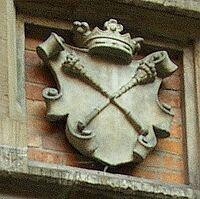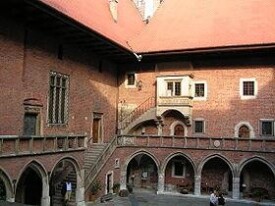克拉科夫雅蓋隆大學
克拉科夫雅蓋隆大學

克拉科夫雅蓋隆大學

克拉科夫雅蓋隆大學
社會學分院歷史學院:考古學分院;人類學分院;歷史學分院;文學史分院;猶太學;音樂學分院。語言學院:古典文學分院;英語分院;德語分院;亞洲分院;波蘭語分院;拉丁語分院;斯拉夫語分院;東斯拉夫語分院;匈牙利語;印歐語;數學與物理學院;數學分院;物理分院;計算機科學分院。生物與地理學院:植物分院;環境科學分院;地理與空間學分院;地質科學分院;動物學分院;生物工程學院:分析生物化學系;物理生物化學系;宏觀生物化學系;微生物化學系;生物物理學系;微生物系;植物生理與進化系;免疫學系。

克拉科夫雅蓋隆大學
2、教學與研究的優越品質,波蘭最主要的綜合研究性大學,名列75所綜合性高等學府之首。“我們深信,今天的克拉科夫雅蓋隆大學不僅是最古老最有聲望的大學,也是最好的大學”,校長Franciszek Ziejka教授如是說。這樣說主要基於兩點:(1)、平均每位大學教師出版的文獻數量最多;(2)、世界公認的引用文獻數量最多;當然教授數量也是最多的。
3、國際知名度,克拉科夫雅蓋隆大學世界聞名,她是歐洲大學聯盟、Utrecht大學同盟和Coimbra團體成員之一。作為波蘭最古老、歐洲前六所的大學,她的聲譽吸引著眾多的國際留學生、政府和國際組織成員。同時值得一提的是,克拉科夫雅蓋隆大學是波蘭唯一的,歐洲極少數中的已經被美國國家教育部完全認可的大學。
4、革新與發展,自創立之初,大學就一直致力於發展新學位、新課程,以滿足波蘭和歐洲當代科學、經濟和政府的需要。近來大學又開設了兩個全新的科系:國際與政治學院;生物工程學院。大學也正在建設一個新的校區,主要容納自然科學系的教學、研究項目,還有公寓、娛樂區和各種文化設施。進而一個大的科學與工程園區將很快設立在這個校區周圍。
5、地理環境和文化生活,位於克拉科夫市,波蘭第三大城市,也是波蘭最早的古都。這座歷史名城是一個獨特的城市,有著歷史悠久的一面,又不斷迸發出當代新思潮,到處最是現代化澎湃發展的新景象。大學每年都舉辦上萬人規模的大型文體活動,學校有學生劇團、廣播台、雜誌報刊,還有詩歌社、舞蹈隊,學生會組織許多社會活動和文化俱樂部。
Poland's King Casimir III realized that the nation needed a class of educated people, especially lawyers, who could codify the country's laws and administer the courts and offices. His efforts to found an institution of higher learning in Poland were rewarded when Pope Urban V granted him permission to open the Cracow Academy. The Royal Charter of Foundation was issued on 12 May, 1364, and a simultanous document was issued by the City Council granting privileges to the Studium Generale. The King provided funding for one chair in liberal arts, two in Medicine, three in Canon Law and five in Roman Law, funded by a quarterly payment taken from the proceeds of the royal monopoly on the salt mines at Wieliczka. Its development was stalled by the death of the king, and later the academy was re-established (1400) by King Wladislaus Jagiełło and his wife Jadwiga. The queen donated all of her personal jewelry to the academy, allowing it to enroll 203 students. The faculties of astronomy, law and theology attracted eminent scholars: for example, Stanisław of Skarbimierz, Paweł Włodkowic, Jan of Głogów, and Albert Brudzewski, who from 1491 to 1495 was one of Nicolaus Copernicus's teachers. Jagiellonian University was the first university in Europe to establish independent chairs in Mathematics and Astronomy.
Founding of the Academy, painting by Jan Matejko
Throughout the history of the University, thousands of students from all over Poland, from Lithuania, Russia, Hungary, Bohemia, Germany and Spain have studied there. In the second half of the 15th century, over 40% of students came from countries other than the Kingdom of Poland. For several centuries, virtually the entire intellectual elite of Poland was educated at the University.
The first chancellor of the academy was Piotr Wysz and the first professors were Czechs, Germans and Poles, many of them trained at the Charles University in Prague in Bohemia. Of the students attending about one third were Poles.
By 1520 Greek philology was introduced by Constanzo Claretti and Wenzel von Hirschberg; Hebrew was also taught.
Jagiellonian University in Krakow Old Town District
The Golden era of the Cracow Academy took place during the Polish Renaissance, between 1500 and 1535, when it was attended by 3215 students in the first decade of the 16th century. As the popularity declined, this record was not surpassed until the late 18th century.
In 1846, after the Kraków Uprising, the city and its university became part of the Austrian Empire. The threat of a closure of the University was dissipated in 1847 by the Austrian Emperor's decree to maintain it. Buildings, like the Collegium novum opened in 1887, were added.
On November 6, 1939, 184 professors were arrested and deported to Sachsenhausen concentration camp during operation codenamed Sonderaktion Krakau. The university, along with the rest of Poland's higher and secondary education was shut down for the remainder of World War II.
The faculty was also suppressed by the Communists in 1954.
In 2007, the administrative offices including those of the Rector and Deans were located at the historic Collegium Novum.
Since 2000 a new complex of university buildings, the so-called Third Campus, is under construction, due for completion in 2010 (public funds earmarked for the project amount to PLN 946,5 mln, or EUR 240 mln). The Third Campus borders the LifeScience Park managed by the Jagiellonian Centre of Innovation.
Notable people connected with the university
Damage to Jagiellonian University during WWII.
Monument to Nicolaus Copernicus next to the Jagiellonian University's Collegium Novum (New College)
Collegium Novum assembly hall
Przegorzały Castle, Institute of European Studies
The Campus of the 600th Anniversary of the Jagiellonian University Revival (The Third Campus)
Saint John Cantius 1390-1473. Scholastic; theologian
Jan Długosz 1415-1480; historian
Laurentius Corvinus 1465-1527; humanist; lecturer at the Academy
Nicolaus Copernicus 1473-1543; astronomer; promoter of heliocentrism
Francysk Skaryna 1485?-1540?; pioneer of the Belorussian language;first to print a book in an Eastern Slavic language (1517 in Prague)
Andrzej Frycz Modrzewski 1503?-1572; diplomat; political thinker; religious thinker
Marcin Kromer 1512-1589; historian; Prince-Bishop of Warmia
Jan Kochanowski 1530-1584; Polish poet
Bartosz Paprocki c.1543 - 1614; writer; historiographer; translator; poet; genealogist
Stanisław Koniecpolski 1590?-1646; military commander; military politician; Grand Hetman of the Crown
John III Sobieski 1629-1696; military leader; monarch of Polish-Lithuanian Commonwealth; victor of the Battle of Vienna
Wincenty Pol 1807-1872; poet; geographer
Ignacy Łukasiewicz 1822 - 1882; pharmacist; deviser of the first method of distilling kerosene from seep oil
Carl Menger 1840-1921; economist; lawyer; founder of the Austrian School of economics
Karol Olszewski 1846-1915; physicist; chemist; the first to liquefy oxygen, nitrogen and carbon dioxide from the atmosphere
Wacław Sierpiński 1882-1969; mathematician
Bronisław Malinowski 1884-1942; anthropologist
Ivo Andric - Nobel laureate
Henryk Sławik 1894-1944; diplomat; designater of a Righteous Among the Nations for the rescue of Jews in World War II Hungary
Tadeusz Pankiewicz 1908-1993; pharmacist; Righteous Among the Nations who aided Jews in the Kraków Ghetto
Józef Cyrankiewicz 1911-1989; communist politician; prime minister of Poland 1947-1970
George Zarnecki 1915-2008; art historian specializing in English Romanesque art
Antoni Kępiński 1918-1972; psychiatrist
Pope John Paul II (Karol Wojtyła) 1920-2005
Zbigniew Czajkowski ("Father of the Polish School of fencing") b. 1921
Stanisław Lem 1921-2006; writer
Bohdan Lepky; writer
Wisława Szymborska b. 1923; poet; 1996 Nobel laureate in Literature
Norman Davies b. 1939; British historian
Krzysztof Zanussi b. 1939; film director
Leo Sternbach 1908-2005; chemist; inventor of the benzodiazepine
Paulo Szot born c. 1970; opera singer; Broadway musical theatre actor
Bat-Erdeniin Batbayar born c. 1954 politician , political analyst and writer.
Kazimierz Papée 1889 - 1979; Polish Ambassador to the Holy See 1939-1958
Outstanding professors
Stanisław of Skarbimierz (1360-1431), rector, theologian, lawyer
Paweł Włodkowic (1370-1435), lawyer, diplomat and politician, representative of Poland on the Council of Constance
Albert Brudzewski (1445-1497), astronomer and mathematician
Maciej Miechowita (1457-1523), historian, chronicler, geographer, medic
Jan Brożek (1585-1652), mathematician, physician and astronomer
Henryk Jordan (1842-1907), professor of obstetrics
Walery Jaworski (1849–1924), gastroenterologist
Władysław Natanson (1864–1937), physicist
Stanisław Estreicher (1869-1939), founder of the Jagiellonian University Museum
Tadeusz Estreicher (1871-1952), pioneer in cryogenics
Marian Smoluchowski (1872-1917), pioneer of statistical physics
Stanisław Kutrzeba (1876-1946), rector, General Secretary of the Polish Academy of Learning
Andrzej Gawroński (1885-1927), founder of the Polish Oriental Society, master of Sanskrit
Stanisław Kot (1885-1975), historian and politician
Tadeusz Sulimirski (1898-1983), historian and archaeologist, experts on the ancient Sarmatians
Stanislaw Smreczynskis(1899-1975) zoologist.
Henryk Niewodniczański (1900-1968), physicist
Bohdan Lepky, literature
Courtyard of the Collegium Maius.
Enrollment
The university has 52,445 students (including 1,612 degree students from abroad) and 3,657 academic staff (2008). About 1130 international non-degree students were enrolled in the year 2007. Programmes of study in 48 disciplines and 93 specialisations are offered. The school has an exchange program with The Catholic University of America and its Columbus School of Law. It also hosts a semester abroad program from University of Wisconsin - Steven's Point and the University of Guelph.
Library
The university's Jagiellonian Library (Biblioteka Jagiellońska) is one of the largest in the country, with almost 6.5 million volumes. It has a large collection of medieval manuscripts , for example Copernicus' De Revolutionibus or Balthasar Behem Codex.
It also gathered the underground literature (so called drugi obieg or samizdat) from the period of communist rule (1945-1989).
2021年軟科世界大學學術排名第401-500位。
